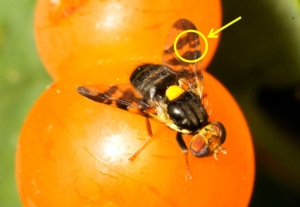
The pattern on the wing of the European Cherry Fruit Fly, Rhagoletis cerasi, can be used to distinguish it from native fruit flies. (Courtesy Steve Paiero,
University of Guelph)
The U.S. Department of Agriculture officials have confirmed that European Cherry Fruit Fly is now present in Niagara County, New York. The invasive pest was first detected in North America in Ontario, Canada, in 2015.
Regulators trapped 22 European Cherry Fruit Flies from 14 different sites along the Niagara River this summer, according to an announcement from the Animal and Plant Health Inspection Service, APHIS. These detections were not in orchards, but rather on wild cherry and honeysuckle species in state parks and other wild areas.
Rhagoletis cerasi is a quarantine pest and major threat in European cherry orchards. It’s closely related to several cherry fruit flies that are native pests to North America and pest control programs already in place would likely be effective against it as well, the Ontario Ministry of Agriculture, Food and Rural Affairs told growers in a newsletter earlier this year.
The larger concern is if R. cerasi makes its way to California, where there are no native cherry fruit flies in the San Joaquin Valley where most of the state’s cherry production resides. An introduced pest would create problems for growers and exports, the California Department of Food and Agriculture told the Good Fruit Grower earlier this year.
How R. cerasi got to Ontario remains unclear. Earlier this year, APHIS banned the import of fresh cherries from Ontario to the U.S. because of the threat presented by the pest and Canadian regulators are prohibiting the movement of Ontario cherries to British Columbia.
APHIS and the New York State Department of Agriculture and Markets are planning further surveys next season, when the pests become active again, and discussing additional response and regulatory actions, according to the APHIS news release issued on October 16.
Learn more about the pest and the problems it may pose in a May, 2017 story from the Good Fruit Grower – https://goodfruit.com/old-world-pest-new-world-wary/






Leave A Comment